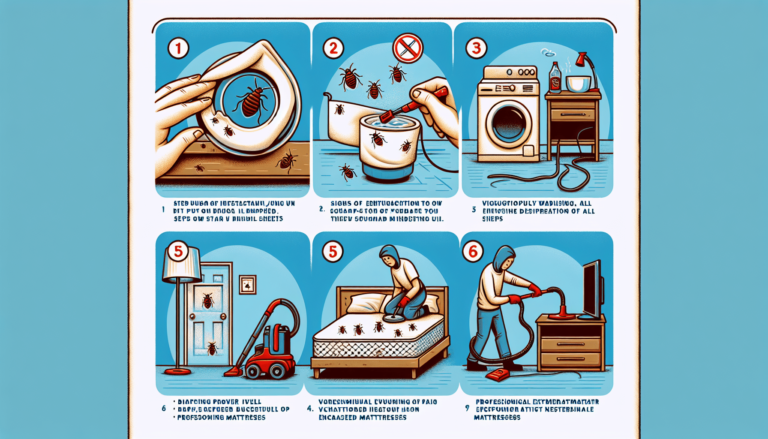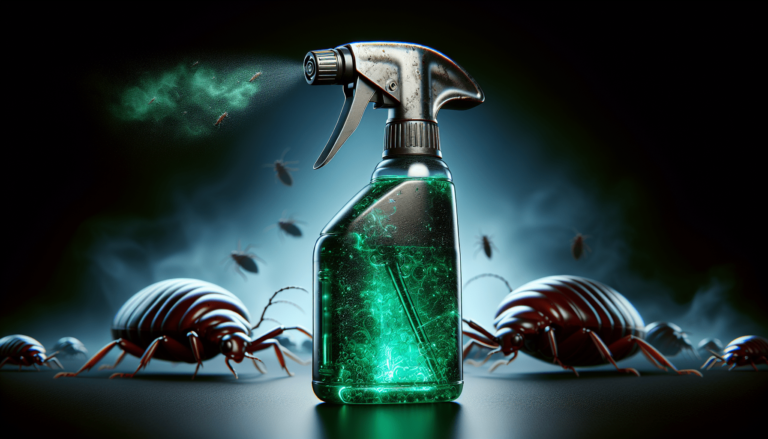How To Prevent Bed Bugs When Traveling
Are you planning your next adventure, ready to explore new destinations and make lasting memories? Before you embark on your journey, it’s important to know how to prevent one of the most unwanted travel companions: bed bugs. These pesky insects can turn a dream trip into a nightmare, causing itchy bites and sleepless nights. In this article, we’ll provide you with expert tips and advice on how to keep bed bugs at bay while traveling. From inspecting your accommodations to protecting your luggage, we’ve got you covered. So, read on to learn how to protect yourself and ensure a bite-free travel experience.

Understanding Bed Bugs
Definition and Nature of Bed Bugs
Bed bugs are small, flat, oval-shaped insects that feed on blood. They are nocturnal creatures and are attracted to warmth and the carbon dioxide we exhale. Bed bugs are resilient pests that can survive in various environments and can quickly infest homes, hotels, and other accommodations.
Life Span and Reproductive Nature
Bed bugs have a relatively short life span, typically ranging from four to six months. However, under favorable conditions, they can survive for up to a year without feeding. Bed bugs reproduce rapidly, with adult females laying around 200-500 eggs in their lifetime. These eggs are tiny and can easily go unnoticed, making it difficult to spot and eradicate an infestation.
Bed Bugs’ Favorite Habitats
Bed bugs are not limited to just beds. They can be found in cracks, crevices, and other hiding spots near sleeping areas, such as furniture, curtains, baseboards, and even behind electrical outlets. They are attracted to places where they can easily access humans during their sleep, as they rely on blood as their primary source of nutrition.
Sources of Bed Bugs while Traveling
When traveling, there are several potential sources of bed bugs. They can hitch a ride on luggage, clothing, or other personal belongings. Common places to encounter them include hotels, hostels, vacation rentals, and even public transportation. Bed bugs are excellent hitchhikers and can quickly spread from one location to another, making it crucial to be proactive in preventing their presence.
Discovering Bed Bugs in Travel Accommodation
Signs of a Bed Bug Infestation
Detecting a bed bug infestation can be challenging, as they are masters of hiding. However, there are some telltale signs to watch out for. These include small blood stains on sheets or pillowcases, dark spots (bed bug excrement) on mattresses or furniture, and a distinct sweet, musty odor. You may also experience itchy bites on your body after waking up.
How to Inspect Your Sleeping Area
Before settling into your travel accommodation, it’s important to perform a thorough inspection to check for bed bugs. Start by examining the mattress, sheets, and headboard for any signs mentioned above. Lift the mattress and inspect the seams, folds, and tufts. Don’t forget to check behind framed pictures and along the edges of carpets. Use a flashlight to aid in your search.
What to Do If You Find Bed Bugs in Your Accommodation
If you confirm the presence of bed bugs in your travel accommodation, it’s crucial to take immediate action. First, notify the management or owner of the establishment. Request a change of room or consider finding alternative accommodation if the infestation is severe. Avoid moving to a neighboring room, as bed bugs can easily spread through walls and outlets. Additionally, take steps to prevent bringing them home by following the guidelines in the next section.
Choosing the Right Accommodation to Avoid Bed Bugs
Researching Accommodations before Booking
To minimize the risk of encountering bed bugs during your travels, it’s essential to research and choose accommodations with a good track record. Look for reviews and ratings specifically mentioning cleanliness and pest control. Check if the establishment has any previous history of bed bug issues. Websites like TripAdvisor and Yelp can provide valuable insights from fellow travelers.
Considerations for Selecting Bug-Free Accommodations
When selecting accommodations, consider staying in newer establishments as they are less likely to have had previous bed bug infestations. Look for accommodations that have proactive measures in place, such as regular inspections and professional pest control services. Additionally, opt for rooms located away from the main entrance and elevators, as bed bugs often initially spread from these areas.
Using Ratings and Reviews to Select Accommodations
Ratings and reviews posted by previous guests can be valuable resources when selecting bug-free accommodations. Look for recent reviews that specifically mention the absence of bed bugs. Pay attention to the overall ratings, cleanliness ratings, and any comments regarding pest control efforts. This information will help you make an informed decision and minimize the risk of encountering bed bugs.
Packing a Bed Bug Prevention Kit
Essential Items for a Bed Bug Prevention Kit
Having a bed bug prevention kit can provide peace of mind while traveling. Some essential items to include in your kit are a flashlight, magnifying glass, bed bug mattress encasements, travel-sized bed bug spray, and resealable plastic bags for storing clothing and belongings. Additionally, consider packing a portable bed bug heater or dryer for treating potentially infested items.
How to Pack Your Kit Efficiently
When packing your bed bug prevention kit, organize the items in a compact and easily accessible manner. Consider using clear plastic containers or bags to keep everything organized and visible. Place the kit in an easily accessible part of your luggage, such as an outer pocket or the top of your suitcase. This way, you can quickly access it for inspections or preventive measures during your trip.
When and How to Use Each Item in the Kit
Knowing when and how to use each item in your bed bug prevention kit is crucial for effectively minimizing the risk of bed bug exposure. Use the flashlight and magnifying glass for thorough inspections upon arrival at your accommodation. If you suspect bed bugs, use the bed bug spray on your sleeping area and inside your luggage. The mattress encasements can provide an added layer of protection for your mattress, while the resealable bags can be used to isolate potentially infested clothing or belongings.
Handling Luggage to Prevent Bed Bug Exposure
Right Types of Luggage for Bed Bug Prevention
Choosing the right luggage can significantly reduce the chances of bed bug exposure. Hardshell suitcases with smooth exteriors are recommended, as they are more difficult for bed bugs to cling to. Avoid using fabric or canvas suitcases, as bed bugs can easily hide in the folds and creases. Additionally, consider using luggage liners or specially designed bed bug-proof luggage covers for added protection.
Safe Handling and Placement of Luggage
When traveling, it’s important to handle and place your luggage safely to minimize the risk of picking up bed bugs. Avoid placing your suitcase directly on the bed, floor, or upholstered furniture. Instead, use luggage racks, shelves, or hard surfaces to keep your luggage elevated and away from potential bed bug hiding spots. Upon returning home, take precautionary measures to prevent any potential bed bugs from infesting your residence.
Tips for Unpacking Safely
When returning from your trip, follow a few simple tips to ensure safe unpacking and prevent any potential bed bugs from entering your home. Unpack your luggage outdoors or in a designated area, such as a garage or laundry room. Inspect your belongings carefully as you remove them from the suitcase. Place clothing directly into the dryer on high heat for at least 15-20 minutes to kill any possible bed bugs. Vacuum and wipe down the inside of your luggage before storing it.
Personal Hygiene and Clothing Considerations
Best Clothing Materials to Deter Bed Bugs
Choosing the right clothing materials can help deter bed bugs from biting. Opt for tightly woven fabrics such as polyester or nylon, as they make it more difficult for bed bugs to penetrate. Avoid loose-fitting clothing or materials like wool or cotton, as these can provide easy access for bed bugs to bite through.
How to Handle, Wash, and Store Clothing during Travel
Proper handling, washing, and storing of clothing are essential in preventing bed bugs during travel. Keep your clothing sealed in resealable plastic bags within your luggage to create a barrier. Upon returning home, immediately wash all clothing in hot water and dry on high heat. Avoid placing dirty clothes back into your suitcase, as any bed bugs or eggs may have hitchhiked during your trip.
Importance of Regular Body Hygiene
Maintaining good personal hygiene is vital in preventing bed bug bites. Showering regularly and thoroughly washing your body can help remove any potential bed bug hitchhikers. Additionally, consider using bed bug repellent lotions or sprays on exposed skin areas before sleeping. These preventative measures, coupled with clean clothing, can significantly reduce the risk of bed bug bites.
Dealing with a Suspected Bed Bug Encounter
Initial Steps to Take after a Suspected Encounter
If you suspect a bed bug encounter during your travels, it’s important to take immediate action. Firstly, remove yourself from the infested area to prevent further bites or possible transportation of bed bugs to other locations. Inspect your clothing and belongings for any signs of bed bugs, such as live bugs, shed skins, or dark spots. Keep all potentially infested items separate and away from unaffected belongings.
Contacting Relevant Authorities or Organizations
If you encounter bed bugs in a hotel or other accommodation, it’s essential to notify the relevant authorities or organizations. Inform the management immediately, providing them with detailed information about your findings. This enables them to take appropriate measures to treat the infestation and prevents the spread of bed bugs to other guests.
Cleaning Process for Clothing and Belongings
After a suspected bed bug encounter, thorough cleaning of your clothing and belongings is necessary to eliminate any potential hitchhikers. Wash all potentially infested items in hot water and dry them on high heat. Items that cannot be laundered should be placed in the dryer on high heat for at least 15-20 minutes. Vacuum and wipe down your luggage, and consider using a bed bug spray specifically designed for treating luggage.
Returning Home after Exposure Risks
Preventing Bed Bug Introduction to Your Home
Upon returning home from your travels, it’s crucial to take steps to prevent any potential bed bugs from infesting your residence. Leave your luggage outside or in a designated quarantine area, such as a garage or basement. Unpack your belongings carefully and inspect them for any signs of bed bugs. Follow the unpacking guidelines mentioned earlier, including washing and high-heat drying of clothing and mattresses.
Initial Inspection and Cleaning Processes
Begin by conducting a thorough inspection of your home to ensure it is free from bed bugs. Focus on areas where an infestation is most likely to occur, such as bedrooms, living rooms, and areas near sleeping areas. Check for signs of bed bugs, including blood stains, dark spots, or live bugs. Vacuum all areas meticulously, paying particular attention to cracks, crevices, and baseboards. Consider using a steam cleaner to treat potential hiding spots.
Professional Services for Bed Bug Extermination
If you suspect a bed bug infestation in your home and are unable to eliminate it yourself, it may be necessary to seek professional help. Pest control companies specializing in bed bug extermination can provide effective treatments tailored to your specific situation. Professional services often involve a combination of chemical treatments, heat treatments, and follow-up inspections to ensure complete eradication.
Understanding Potential Health Risks
Physical Health Implications of Bed Bug Bites
Bed bug bites can cause physical discomfort, including itchiness, redness, and swelling. While most people do not experience severe reactions to bed bug bites, some individuals may develop allergic reactions or secondary infections from scratching the bites. It is crucial to resist the urge to scratch the bites to avoid complications.
Psychological Effects a Bed Bug Encounter can Cause
Encountering bed bugs during travel can have psychological effects, causing anxiety, stress, and sleep disturbances. The fear of bringing bed bugs home and the resulting infestation can lead to feelings of unease and paranoia. It’s important to address these psychological effects and seek support if needed. Sharing your experience and advice with others can also help alleviate any lingering anxieties.
Treatment Options for Bed Bug Bites
If you experience bed bug bites, there are several methods to alleviate the symptoms. Applying topical creams or ointments containing hydrocortisone can help reduce itching and inflammation. Over-the-counter antihistamines can provide relief for allergic reactions. In severe cases, a doctor may prescribe stronger medication or recommend professional treatment options. As with any health concern, it’s best to consult with a healthcare professional for proper diagnosis and treatment recommendations.
Community Engagement and Awareness
Sharing Your Experience and Advice
After dealing with a bed bug encounter, sharing your experience and advice can help educate and inform others. Writing online reviews for accommodations, sharing travel tips, or contributing to online forums can provide valuable insight and support for fellow travelers. By sharing your knowledge, you can play a part in raising awareness about bed bugs and promoting effective prevention strategies.
Supporting Programs and Policies for Bed Bug Control
Supporting programs and policies for bed bug control is essential in maintaining community-wide efforts to prevent infestations. Stay informed about local initiatives and organizations dedicated to bed bug awareness and prevention. Consider donating to or volunteering with local shelters, community centers, or pest control agencies that offer education and assistance to those affected by bed bugs.
Staying Informed about the Latest Bed Bug Prevention Strategies
The field of bed bug prevention and control is constantly evolving, with new research and strategies emerging. Stay informed about the latest developments and prevention strategies by following reputable sources such as the Centers for Disease Control and Prevention (CDC) and professional pest control organizations. By staying up-to-date, you can continue to protect yourself and others from the nuisance and potential health risks associated with bed bugs.
In conclusion, understanding bed bugs and implementing preventive measures is crucial for a pleasant and worry-free travel experience. By familiarizing yourself with the signs of infestation, choosing accommodations wisely, packing a bed bug prevention kit, and practicing good personal hygiene, you can greatly reduce the risk of encountering bed bugs during your travels. Remember to be vigilant, proactive, and always report any suspected bed bug infestations to prevent their spread and protect fellow travelers.









